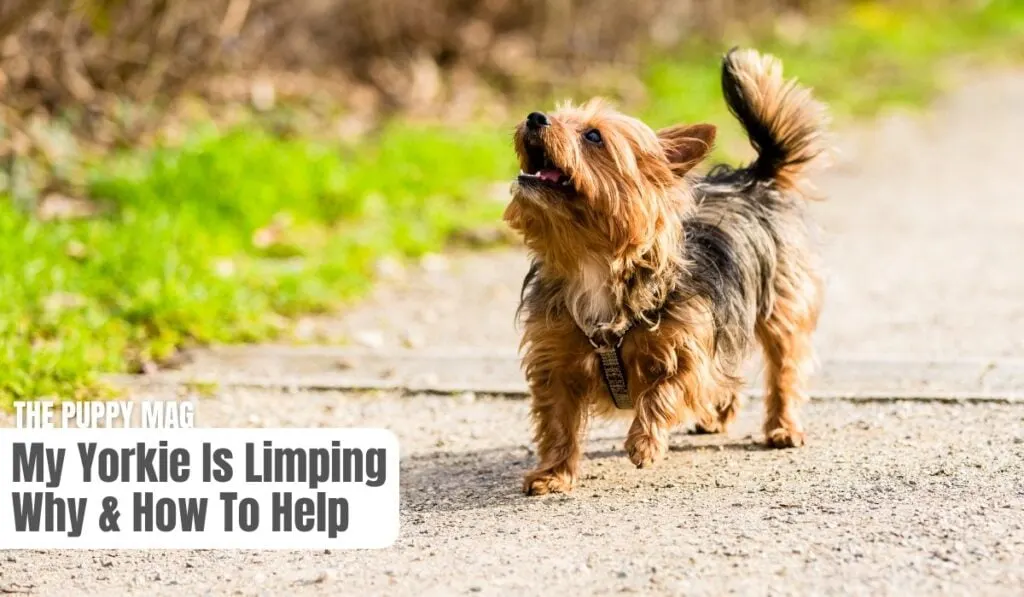When your Yorkie starts limping, be it on a front or back leg, understanding the cause, assessing the seriousness, and knowing the appropriate response are crucial.
In this article, we’ll explore potential reasons behind your Yorkie’s limp and discuss the next steps you should take.

4 Reasons Why Your Yorkie Is Limping
When your Yorkie starts limping, it’s definitely worrying!
When my 4 year old start limping I was immediately worried thinking about what happened and whether or not it’s serious...
The reasons behind this can be many. Yorkies, like other dog breeds, may limp due to a range of factors such as sprains, broken bones, fractures, joint or ligament issues, dislocations, injuries to the paw, or issues related to the spine.
Paw Issues
One common reason why your Yorkie might be limping is a paw injury. It could be that your little furry friend has stepped on something sharp or irritating during their latest walk.
This prompts them to try and keep their paw off the ground, leading to a limp.
Yorkies’ paws are sensitive and can easily be affected by sharp objects, temperature changes, or harmful chemicals. This is a prevalent issue, particularly if your Yorkie spends a lot of time outside in public places.
General Injuries or Trauma
Yorkies, just like us, can suffer injuries from everyday accidents. They can sprain a leg, stumble over an object, or even suffer from strain due to overexertion.
Such injuries are, in fact, the most common cause of limping in dogs and can range in severity.
Yorkies, despite their small size, are energetic and love to jump around. However, this can lead to injuries. It’s advisable to prevent your Yorkie from jumping too much, especially from higher surfaces like sofas or beds.
Here are some potential causes of general injury or trauma:
● Jumping on or off furniture
● Going up and down stairs excessively
● Falling from elevated surfaces
● Overexertion from exercise
● Running too fast or too long
● Slipping on icy surfaces
● Getting paws or legs caught in doors
● Accidental stepping on their paws or legs
Spinal Problems
The breed’s physical structure makes Yorkies particularly prone to spinal issues, such as Intervertebral Disc Disease (IVDD). In this condition, the discs between the spinal bones either bulge or rupture.
These abnormal discs can press on nerves along the spine, causing severe pain, movement difficulties, and in severe cases, even paralysis.
Frequent jumping and hard landings are common culprits that lead to such spinal problems.
Joint Disorders
Joint health is a significant concern, particularly as your Yorkie ages.
The umbrella term “joint disease” includes a host of conditions such as hip dysplasia, osteoarthritis, elbow dysplasia, ligament disease, intervertebral disk disease, and osteochondritis dissecans.
These conditions can occur due to various reasons and at different life stages. Although generally seen in older dogs, certain problems like IVDD and hip/elbow dysplasia can occur even when Yorkies are still puppies.

When To See a Veterinarian
The truth is, it’s challenging for any of us to determine the exact cause of a Yorkie’s limping unless it’s due to an evident issue such as a fresh wound on the paw.
If it’s not evident why your Yorkie is limping, then our best advice is to contact your veterinarian.
A phone call can provide you with immediate insights and allow you to schedule a necessary appointment.
However, you may notice your Yorkie limping when the vet’s office is closed…
Whether it’s a sudden or gradual limp, if it doesn’t appear to cause severe discomfort or pain to your Yorkie, it can typically wait for a few hours. As soon as possible, though, you should contact a veterinarian.
⭐ Instances like broken bones, dislocations (dragging limbs), or severe wounds are time-critical and must be addressed promptly.
Seek immediate help at an emergency veterinary center or your local vet if you notice any of the following:
● Visible fractures or unnatural bends
● Serious wounds and profuse bleeding
● Legs or limbs that are hanging or dragging (indicative of dislocation)
● An unusually warm limb
● Severe weakness
Hopefully, your Yorkie’s situation isn’t dire and they aren’t in noticeable pain.
So, to summarize: If you’re unsure about what’s causing your Yorkie to limp, calling your local vet is the safest bet. If your Yorkie isn’t in pain, it’s generally acceptable to wait a few hours if the vet’s office is closed.
Gradual Onset Limping vs. Sudden Limping
The nature of your Yorkie’s limp, whether it’s a sudden occurrence or has been progressively developing over time, holds significant implications.
Gradual onset limping often suggests an underlying chronic health issue or disease, which can potentially be more serious than sudden limping, usually indicative of a recent injury or minor cut.
When assessing the situation, it’s important to consider whether the limp emerged suddenly or gradually, as this will likely be one of the first questions your vet asks. This information is vital for an accurate diagnosis.
Regardless of whether it’s a sudden or gradual limp, it’s crucial to treat it with seriousness. It’s always best to have it professionally examined.
What To Do Now
Until you’ve determined the exact cause of your Yorkie’s limp and have reached out to your vet, it’s advisable to maintain a calm environment and limit physical activities like walking, jumping, or playful roughhousing.
Rest plays a vital role in healing. Just as we humans would exacerbate a sprained ankle by excessive movement, the same principle applies to your furry friend.
If the limp is due to a minor scrape or insignificant cut, a vet visit might not be necessary. However, a quick call to the vet can provide you with guidance on addressing the issue at home.
Treatment for small cuts on the pads usually involves cleaning the wound to ensure it’s free from debris and then applying a bandage. At times, topical ointments (like Polysporin) may be recommended. Again, a quick consultation with your vet is always the best route.
Related: Can Polysporin Be Used on Dogs?
Until your Yorkie regains their normal gait, it’s important to significantly scale back on their physical activities and exercise.
Back Leg Limping But With No Obvious Pain
Yorkie owners frequently observe their pet limping on their back leg, seemingly without any pain.
So, what exactly is going on?
If your Yorkie doesn’t appear to be in discomfort, the limp is generally attributed to a minor injury such as a slight sprain or superficial cut. Many dogs can still walk, or even run, despite these minor issues, though it’s best if they don’t.
In other less serious cases, owners might mistake a hop or skip in the dog’s gait for a limp. Many small dogs exhibit a skipping motion in their back legs for reasons we don’t fully understand. So, ensure this isn’t what you’re observing.
Final Thoughts
A limping Yorkie should never be ignored or overlooked. Whether the limp occurs suddenly or gradually, it needs to be addressed. Sometimes your Yorkie may be limping due to a simple cut or sprain, but it could also indicate a more significant underlying health issue.
